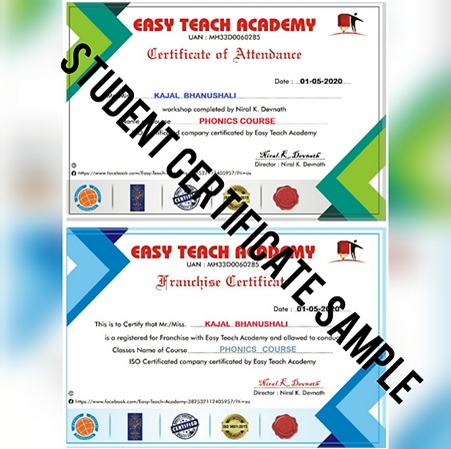Phonics Course For Teachers
We think that phonics is a segment of the reading exercise and should be taught separately it is part of the ability to read and write. This course is brought in innovative ways with teaching aids, games, worksheets, etc...
Syllabus:
1. Introduction of phonics. Why it is important? What is Indian Phonics & Foreign Phonics?
2. 42 Letter Learning sounds Sentences learning Information.
3. Method Tricky words & sight words.
4. Learn short & Long vowel sound.
5. Learn vowel & Consonant.
6. Learn Staring ‘C’ & ‘K’.
7. Learn ending ‘ck’.
8. Learn Flosszz Words.
9. Sentences formation of 3 letters.
10. Initial Consonant Blends.
11. Final Consonant Blends.
12. Consonant digraph means no vowel letter.
13. Vowel Diagraph.
14. R-controlled words.
15. Magic - E
16. ‘C’ & ‘G’ Double Sounds.
17. Silent Letters.
18. How to Read Story Books.
19. Long Vowel Sounds / Alternative Sounds
20. Diphthongs
21. What are Triagraph
22. Homophones
23. Contraction
24. Anagrams
25. What are irregular words
26. 15 Games will be taught.
Certificate in Teaching English Phonics is a modern course designed for teachers teaching English to primary level students. The course helps them to get a good grab of the techniques to teach students the effectiveness of pronunciation can be completed in 1 week of continuous lectures. The certificate course offers enough flexibility to the tutor who can pursue it from any part of the globe in online mode. This course is the best option and show to be advantageous for the teachers planning to enter the English language arena or looking to upgrade their teaching skills as phonics teaching skill is essential for English language teachers.
Course Duration
- Maximum duration of the course is one week.
- Flexible course which can be pursued from any area of the globe.
- Three Days Live sessions online on Zoom / Google meet/ offline at centre.
- One or one and half hour session.
Take Away
- Two certificates will be provided. (Attendance certificate + Franchise certificate)
- Lots of PDF worksheets through email will be send.
- Two books (paper back).
Eligibility
- Teaching English Phonics is a short modular course.
- Both ambitious as well as experienced teachers are eligible to apply 10th pass.
- You are eligible to join this ISO-certified course in Phonics Teacher's Training if you possess a basic knowledge of the English Language.
Career Scope
You will get a professionally ISO Certificate of Phonics Teacher.
each an easy to entry point into CBSE / ICSE / IGCSE/ IB/ State board schools.
- Get jobs as Phonics Teacher in:
- Pre-schools.
- For Pre-Primary and Primary Levels at schools.
- Open your Phonics Classes from home or in the institute.

Frequently Asked Questions
In implementing systematic phonics instruction, educators must keep the end in mind and ensure that children understand the purpose of learning letter sounds and that they are able to apply these skills accurately and fluently in their daily reading and writing activities.
They must acquire foundational knowledge, including phonemic segmentation, grapheme–phoneme knowledge, decoding, and spelling skills. When these skills are applied, spellings of words become bonded to pronunciations and meanings and stored in memory. Suggestions for teaching these skills are offered.
Phonics instruction is most effective when it begins in kindergarten or first grade. To be effective with young learners, systematic instruction must be designed appropriately and taught carefully. It should include teaching letter shapes and names, phonemic awareness, and all major letter-sound relationships.
5 Simple Ways To Build Phonics Skills and Phonemic Awareness -
It helps children hear, identify and use different sounds that distinguish one word from another in the English language. Written language can be compared to a code, so knowing the sounds of individual letters and how those letters sound when they're combined will help children decode words as they read.
Help students understand the purpose of phonics by engaging them in reading and writing activities that requires them to apply the phonics information you've taught them. Use manipulatives to help teach letter-sound relationships. These can include counters, sound boxes, and magnetic letters.
5 Key Characteristics of Effective Phonics Instruction
In teaching phonics explicitly and systematically, several different instructional approaches have been used. These include synthetic phonics, analytic phonics, embedded phonics, analogy phonics, onset-rime phonics, and phonics through spelling.

